Fishing Boat Ownership Page Two
Fishing Boat Ownership Page Two will help you understand basic boat maintenance, boat storage, boating regulations and boat etiquette. First and foremost PFT recommends: Read Your Manual! Review your Boat Owners Manual for helpful guidance when you get started. The less experience you have driving a boat the more important this becomes. In addition, most states offer a boat owners manual at the respective DNR offices.
Here are the five topics Practical Fishing Tips will cover on fishing boat ownership page two.
- Driving Your boat on the water
- Loading Your boat on the trailer at the boat ramp
- Boat Storage
- Basic Boat Maintenance
- Boat Regulations
Step 1: Review Owners Manual
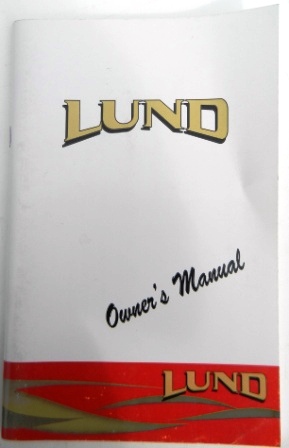 Boat Owner's Manual
Boat Owner's Manual
You will find valuable information inside - similar to the study guide you receive when you are renewing your license to drive a car. Including in these manual are basic boat safety, life jacket information, on the water etiquette, how to pass and on which side, proper lighting for boats, importance of not overloading, and much, much more.
Driving Your Boat On Water
Fishing Boat Ownership Page Two includes additional great topics. A good rule of thumb: Learn to watch where the front of the boat is headed compared to a fixed point on a shoreline ahead like a tree or tower. Always be looking around you at other boats and what direction and their direction of travel compared to your travel. Anticipate that the other driver does not see you! Usually you try to pass on the right of other boats. Allow more space if a boat appears to be moving to your right side. Getting up on plane is the best way to travel a distance. Trolling, simply a slow speed, is best around obstacles, where there are many boats, and when fishing slowly by pulling lures through the water.
The biggest difference between driving your boat and driving your car is you don't have rubber wheels touching something solid beneath you. You do not have brakes like in a car. This means a good understanding of momentum is important. Even though there is friction of water on the bottom of your boat, the boat will feel like it is slipping through the water. It will "slip" forward, sideways or in a circle depending on which way your propellor pushed the boat. What this means is that you must allow more time and space to stop by slowing down sooner rather than later.
When you launch your boat practice at slow speeds - moving forward, shifting to neutral, stopping using reverse, backing up using reverse and then turn and stop the turn. These moves will all be important when loading your boat back onto your trailer. Fishing Boat Ownership Page Two also includes this never do item: Never shift into reverse directly from full speed forward.
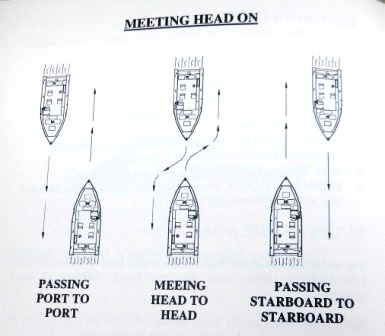 Owner's Manual: Passing Another Boat
Owner's Manual: Passing Another Boat
Boat Owner's Manuals will show you rules of driving your boat like how to pass another boat safely. Of course you are assuming that the other boat driver has read their owner's manual. Driving while drunk on a boat is not any different than DUI in a car. Bad things happen. We report two accidents that should not have heppene: One where a personal water craft out of control cut in front of a ski boat that was underway pulling a skier. The PWC was cut in half. Fortunately the PWC driver was not injured. Another situation a group of friends riding on a deck boat were returning to their cabin after dark on a very busy lake with their after dark lights on, traveling at a slow speed. A cigar boat going at cruising speed hit them broad side went up and over the deck boat. Several were seriously injured, one fatally. Accidents can happen, most can be prevented by being constantly vigilant.
Loading Boat at Boat Ramp
When returning to the marina or boat launch area, be sure to observe the no wake signs. With experience you can learn to place your boat right next to the dock, or right on the trailer just like a pro. Ask a friend to give you lessons: Learn how your friend does the following: starting, stopping, turning, trimming the motor, how do they get the boat on plane? Also practice and learn handling and maneuvering your boat close to the boat ramp. At the boat ramp slow and steady is needed, it is not a race – you need momentum but not speed.
With practice you will learn the proper placement of the trailer in the water for easiest loading of your boat. Use the side rails, fenders, or some other part of the trailer for placement in the water. As you drive the boat towards the trailer, remember most driver seats are on the right side of the boat so aim your position as if you will travel over the right side of the trailer, this means that the center of the boat will likely be close to the center of the trailer. This is more tricky if there is wind as you may find that wind will push your approach out of alignment. Practice makes perfect - and many times the last few inches can be completed with the trailer winch.
Boat Maintenance
Your fishing boat ownership is a big investment, so invest time in performing routine maintenance. Your owners manual will explain common maintenance procedures. Some of which can be easily done at home, while other procedures will require a professional. Your motor or engine will require annual maintenance. Do this routinely and enjoy years of trouble free service,
Fishing Boat Ownership Maintenance List
Routine Boat Body Care should include washing and waxing. Clean regularly, and repair minor scrapes / scratches as needed. Touch up minor scrapes with paint on your trailer. Batteries require routine care and you will maximize how long they will give you service. Deep cycle batteries are designed to be drained and then fully charged up again. After a full day on the lake using your trolling motor, you will want to recharge your trolling motor deep cycle batteries. Batteries not used over winter are best stored hooked to a trickle charger. However, attention to routine maintenance means that the majority of the time you spend with your boat can be on the water fishing.
Fishing Boat Ownership Page Two - Boat Storage
 Marina Boat Storage Slips
Marina Boat Storage Slips
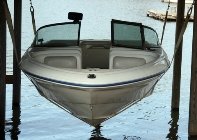 Boat Lift for Marina Slip Storage
Boat Lift for Marina Slip Storage
Boating Registration / Regulations
Pick up a copy and review your state boating regulations. You can get these from the state department of wildlife in person or on line, or pick up a copy from the water patrol. Most sport and fishing shows will have your state water patrol booth where you can pick one up. Your owner's manual will have a list of common items needed for boat safety shown below. Outfit your boat with all the requirements for safety. Don't be surprised if from time to time a water patrol officer will want to stop and visit with you. They will want to see your safety articles required by each state.
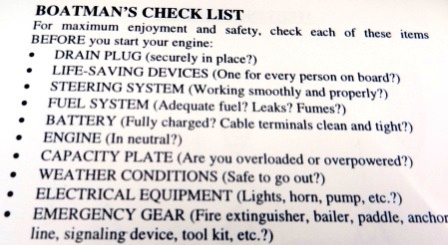 Boatman's Checklist from Owner's Manual
Boatman's Checklist from Owner's Manual
We at PFT encourage you to introduce yourself to your water patrol agents if given the opportunity. They can even offer an inspection of your boat and will let you know if there is a safety area that needs attention. We suggest that you invite an inspection from a water patrol agent. You may think you have everything covered, but will feel better knowing that you do. On one of our teams first used boat with inboard engine the Missouri Water Patrol Agent actually found that the engine compartment exhaust fan was not venting air and gas vapors properly, and a simple adjustment fixed the problem. Needless to say, we were very thankful to have learned this. As the owner of your own fishing boat it is your responsibility to run your boat safely for your self and your passengers. Here is what one owner's manual says about exhaust fumes from an outboard motor:
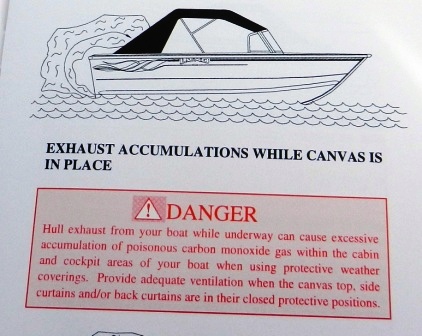 Owner's Manual: Exhaust Accumulations from Outboard Warning
Owner's Manual: Exhaust Accumulations from Outboard Warning